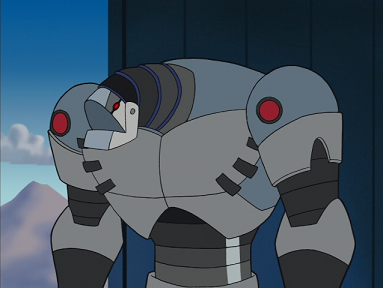The
Zeta Project was a spin-off from the Batman
Beyond second season episode “Zeta.” It centered on Infiltration
Unit Zeta (Diedrich Bader), a synthoid designed to carry out covert
assassination missions for the National
Security Agency through the use of his holographic disguises. However,
it was learned that his creator, Dr. Selig (George Segal & Hal Linden), installed a module in Zeta
that gave him a conscience. On his last mission for the NSA, Zeta’s target
proved to be innocent and he decided he could no longer kill.
 |
| Zeta and Ro running from Agents Bennet and West. |
The agency, believing Zeta a dangerous rogue element that joined the terrorist
organization he was investigating, Brother’s Day, dispatched a team with the
sole purpose of either retrieving or destroying him. It was led by Agent James
Bennet (Kurtwood Smith), who strongly believed Zeta was simply reprogrammed by
enemies and not an actually sentient being. Under him was the young and
egotistical Agent West (Michael Rosenbaum) and Agent Lee (Lauren Tom), who grew
to see there was more to Zeta than they believed and began to subtly help him
evade capture. When Lee left the team and was subsequently promoted, she was
replaced by by-the-book Agent Rush (Erika Alexander & Dominique Jennings).
Other foes during the series included the cybernetically-enhanced bounty hunter Krick (Keith Szarabajka & Richard Moll), cyber-hackers Plug (Paul Amendt), Meg (Amy Danles) and Buss (Googy Gress), high-ranking
Brother’s Day terrorist Titus Sweete (Robert Costanzo), and his
more-advanced counterpart, Infiltration Unit 7 (Bader).
 |
| Infiltration Unit 7. |
Joining Zeta on his adventures was 15-year-old orphan Rosalie “Ro” Rowan (Julie
Nathanson). Initially seeing Zeta as an opportunity, Ro came to care about Zeta
and decided to help him on his quest. Zeta also worked to help her locate her
biological family. Occasionally, they were aided in their efforts by child
genius Bucky Buenaventura (Ulises Cuadra & Blayn Barbosa), a technology
whiz. Batman (Will Friedle) also made a
singular appearance on the show, aiding Zeta against Infiltration Unit 7.
The Zeta Project debuted on The WB on January
27, 2001 as part of their Kids’ WB! programming
block. The series was developed by Robert Goodman, who created Zeta
and wrote his debut episode. “Zeta” wasn’t originally intended as a backdoor
pilot, but Goodman decided that the concept could make a decent series and,
within the year, the network agreed. Zeta’s appearance was reworked to make him
appear more human, and he and Bennett’s voices were recast having been
originally played by Gary Cole and Joe Spano, respectively.
 |
| Zeta's original appearance on Batman Beyond. |
Although it was part of the DC
Animated Universe and produced by Warner
Bros. Animation, the series’ first season had a decidedly different appearance
than all of the other programs. The scenery was generally very light and the
characters lacked any sort of shading, as well had an overall differing
appearance from the models seen since the debut of Superman:
The Animated Series. The stories themselves also took on a comparatively lighter
tonality than the rest of the DCAU. For the second season, the animation
was modified to bring it more in line with the other DCAU shows with darker
settings, shadows, and a sleeker design for Zeta. The stories were also more
action-oriented and intense, increasing the level of danger and excitement in
each episode.
 |
| Zeta and Ro between the seasons. |
The
series was animated mostly by Koko Enterprises
Co., LTD. and DR Digital Co., LTD, with some
episodes done by Sun Min Image
Pictures and Dong Woo Animation. The series was
written by Goodman, along with Hilary J. Bader, Kevin Hopps, Ralph Soll, Rich Fogel, Stacey Liss Goodman, Wendell Morris, Tom Sheppard, Paul Diamond, Katy Cooper, Ned Teitlebaum, Joseph Kuhr, Liz Holzman, Randy Rogel, Lyle Weldon, David Benullo and Christopher Simmons. Hopps and Fogel
were also the show’s story editors along with Goodman. Lolita Ritmanis,
Kristopher Carter and Michael McCuistion served as the
series’ composers, with Ritmanis also composing the theme song.
 |
| Zeta's hologram mode. |
The Zeta Project managed to generate
decent ratings and a loyal fanbase despite episodes being constantly delayed to
allow the network time to run new--and often failed--programs in its timeslot.
The network handed down a mandate that if the production wanted to see a third
season, the second had to end on a cliffhanger. They also had plans for the
third season that took the show places that Goodman wasn’t completely
happy about. All of that proved moot, however, when the network
ultimately decided to cancel it at the end of the second season. During its
run, it managed to earn four Annie Awards and two Daytime Emmy Awards nominations,
and won two Women’s Image
Network Awards. Zeta’s debut also earned an Annie nomination.
 |
| Promotional material for the original DVD release. |
Zeta and Ro would make one final appearance in the Batman Beyond episode “Countdown”
and Zeta as a cameo in Batman
Beyond Unlimited #16 before
ultimately disappearing into creative limbo. Zeta’s original design, however,
would be recycled for the training robots used by the Justice League in Justice
League. In 2009, Warner Home Video released the complete first
season on DVD. In 2017, Warner Archive re-released
the first season and released the second for the first
time.


No comments:
Post a Comment